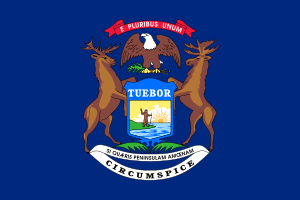Gabriel Richard
| Father Gabriel Richard | |
|---|---|
 Portrait of Father Gabriel Richard | |
| Born |
Gabriel Richard October 15, 1767 La Ville de Saintes, France. |
| Died |
September 13, 1832 (aged 64) Detroit, Michigan |
| Cause of death | Cholera |
| Resting place | Crypt in St. Anne's. |
Father Gabriel Richard (October 15, 1767 – September 13, 1832) was a French Roman Catholic priest and founder of the University of Michigan who became a Delegate from Michigan Territory to the U.S. House of Representatives.
Early life
He was born in La Ville de Saintes, France and entered the seminary in Angers in 1784 and was ordained on October 15, 1790. In 1792, he emigrated to Baltimore, Maryland. He taught mathematics at St. Mary's Seminary in Baltimore, until being assigned by Bishop Carroll to do missionary work to the Indians in the Northwest Territory. He was first stationed in what is now Kaskaskia, Illinois, and later in Detroit, Michigan. Fr. Richard was a priest of the Society of Saint-Sulpice.[1]
Work in Detroit

Richard arrived in Detroit on the Feast of Corpus Christi in June 1798[2] to be the assistant pastor at Ste. Anne's Church. In 1804 he opened a school in Detroit, but this was destroyed by the fire that leveled the city in 1805. This is when Fr. Gabriel Richard wrote the city of Detroit's motto: Speramus meliora; resurget cineribus[3]; In English: "We hope for better things; it will arise from the ashes." Fr. Richard organized the shipment of food aid to the city from neighboring ribbon farms in order to alleviate a food crisis following the loss of the city's supply of livestock and grain.[4]
In 1807, he was invited by a Protestant congregation to act as their clergyman. He did so successfully by concentrating on the elements of Christianity where they agreed. He had the first printing press in Detroit and published a periodical in the French language entitled Essais du Michigan, as well as The Michigan Essay, or Impartial Observer, in 1809. He was strongly in favor of the War of 1812 and trading with China.
Father Richard ministered among the Indians of the region and was generally admired by them. During the War of 1812, Richard was imprisoned by the British for refusing to swear an oath of allegiance after their capture of Detroit, saying, "I have taken an oath to support the Constitution of the United States and I cannot take another. Do with me as you please." He was released when the Shawnee chief Tecumseh, in spite of his hatred for the Americans, refused to fight for the British while Richard was imprisoned.[5]
Together with Chief Justice Augustus B. Woodward, Richard was a co-founder of the Catholepistemiad of Michigania (which would become the University of Michigan), authorized by the legislature in 1817. He served as its Vice-President from 1817 to 1821. Following the reorganization of the University in 1821, he was appointed to its Board of Trustees and served until his death.
Political career
Father Richard was elected as a nonvoting delegate of the Michigan Territory to the U.S. House of Representatives for the 18th Congress, and was the first Catholic priest to be elected to that body, serving a single term, 1823-1825. He secured the first federal appropriation for a road across Michigan's lower peninsula; it was developed as Michigan Avenue, connecting Detroit with Chicago.[6] Richard was an unsuccessful candidate for reelection in 1824, being succeeded by Austin Eli Wing, a member of the Whig Party.
In 1832, after assisting cholera victims night and day during an epidemic, Gabriel Richard died of cholera in Detroit. By some accounts, he was said to die of exhaustion. He was buried in a crypt in St. Anne's.
Legacy

- A bronze bust of Richard marks his tomb within Ste. Anne Church.
- A State of Michigan Historical Marker commemorates Fr. Richard outside Ste. Anne Church in Detroit.
There are at least four schools near Detroit named after Fr. Gabriel Richard:
- Gabriel Richard High School in Riverview, Michigan
- Father Gabriel Richard High School in Ann Arbor, Michigan
- Gabriel Richard Elementary School in Detroit
- Père Gabriel Richard Elementary School in Grosse Pointe Farms, Michigan.
The motto that he first penned, Speramus meliora; resurget cineribus, continues to be the official motto of the City of Detroit.
Notes
- ↑ Farmer, Silas (1890). History of Detroit and Wayne County and Early Michigan: A Chronological Cyclopedia of the Past and Present. Detroit: Silas Farmer & Co. p. 531.
- ↑ Farmer, Silas (1890). History of Detroit and Wayne County and Early Michigan: A Chronological Cyclopedia of the Past and Present. Detroit: Silas Farmer & Co. p. 531.
- ↑ "Detroit: Speramus meliora resurget cineribus". Michigan House Republicans. 2015. Retrieved September 27, 2015.
- ↑ Catlin, George B. (1923). The Story of Detroit. Detroit: The Detroit News. p. 118.
- ↑ Houston
- ↑ Catlin, George B. (1923). Story of Detroit, The. Detroit: Detroit News, The. p. 270.
See also
- Robert Drinan, the first priest to serve as a voting member of Congress
References
- United States Congress. "Gabriel Richard (id: R000210)". Biographical Directory of the United States Congress.
- The Political Graveyard
- Houston, Kay, "Father Gabriel Richard: Detroit's pioneer priest", The Detroit News
- Pargellis, Stanley McCrory. Father Gabriel Richard. (Cass Lectureship Series, 1948). Detroit: Wayne University Press, 1950.
- The Detroit Almanac: 300 Years of Life in the Motor City. Ed. Peter Gavrilovich and Bill McGraw. Detroit: Detroit Free Press, 2000.
External links
| United States House of Representatives | ||
|---|---|---|
| Preceded by Solomon Sibley |
Delegate to the U.S. House of Representatives from Michigan Territory 1823–1825 |
Succeeded by Austin Eli Wing |


